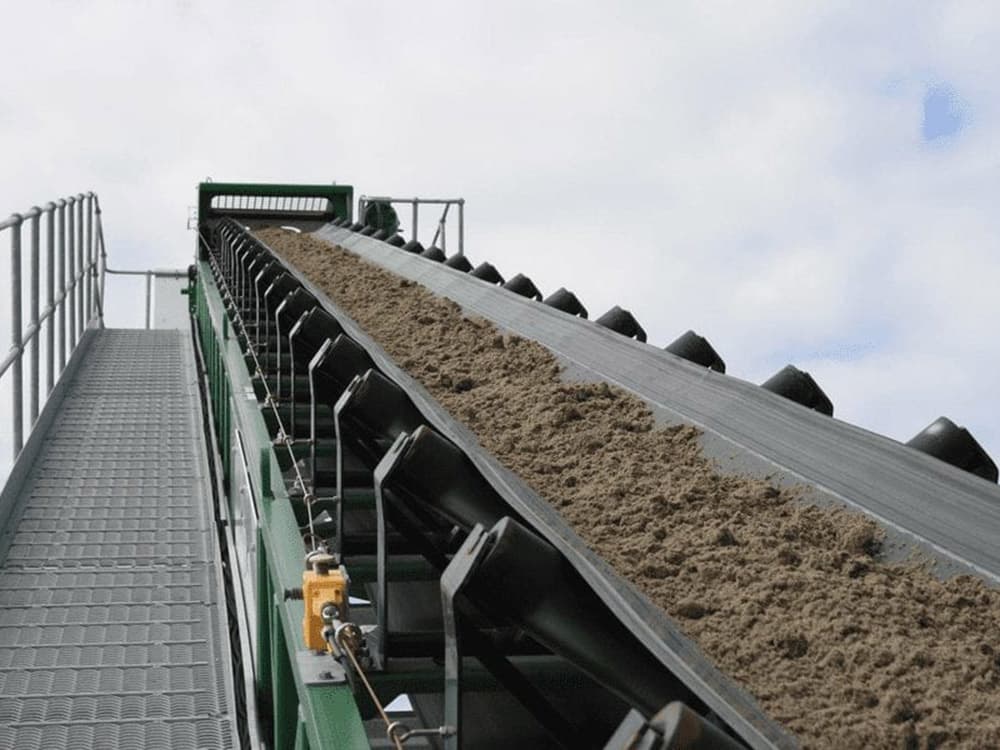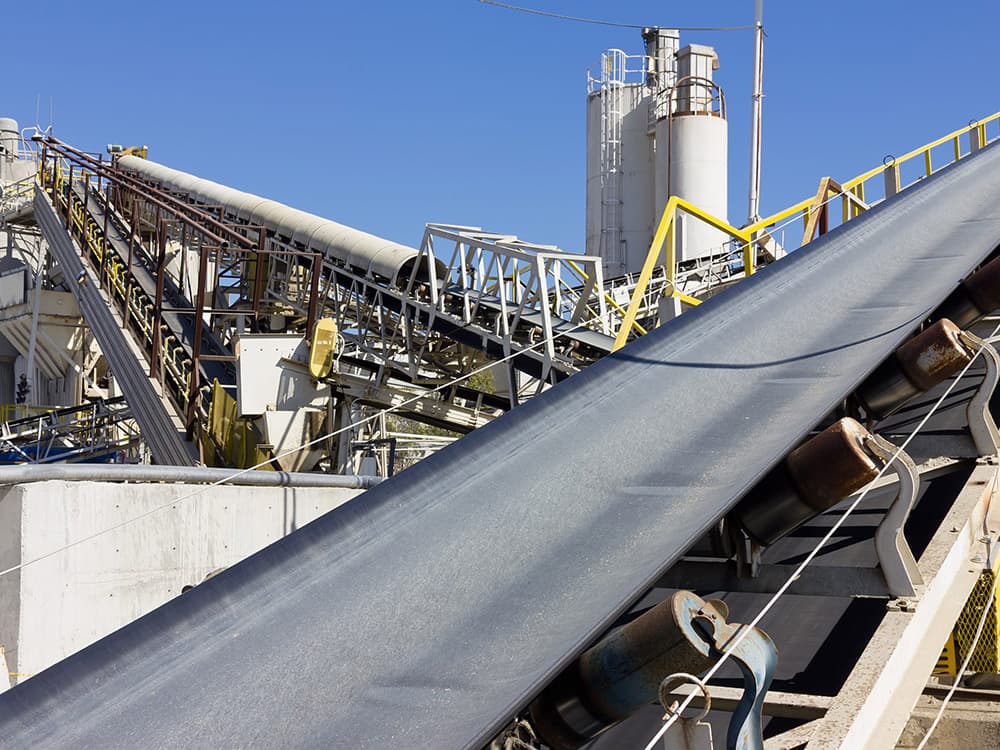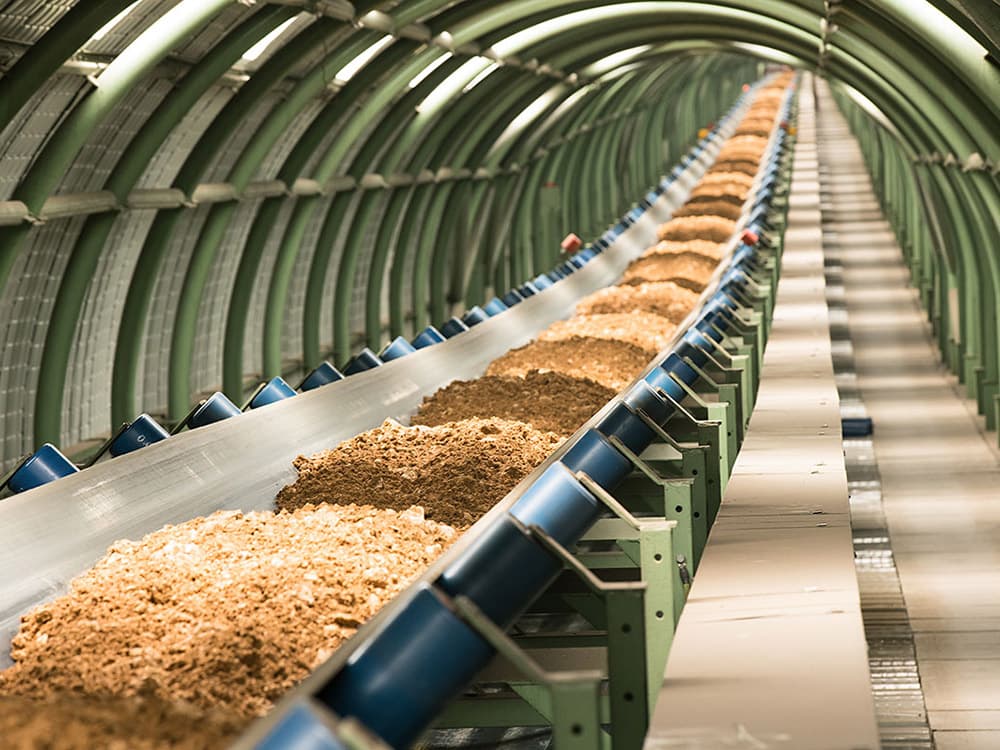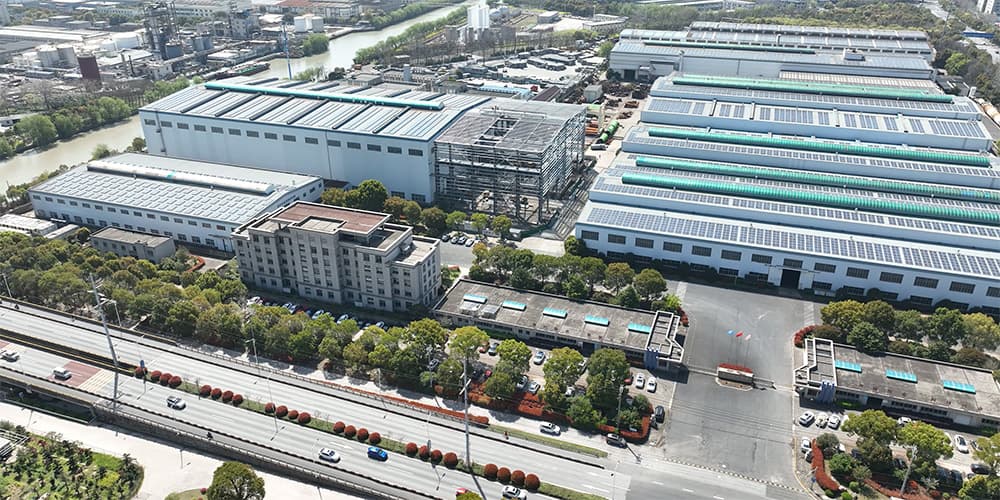Troughed Belt Conveyor Frequently Asked Questions (FAQs)
Trough belt conveyor is a widely used equipment in industrial production for conveying various bulk materials. Because of its structure and function of the special, many users in the purchase and use of the process will produce some questions. This article will address these common questions for detailed answers to help you better understand and apply the trough belt conveyor.

Summary of Frequently Asked Questions about Trough Belt Conveyors
What is a trough belt conveyor?
Trough belt conveyor is a kind of conveying equipment which is supported by inclined roller to form a “V” shaped trough. This design effectively restrains bulk materials on the belt, minimizing scattering and spillage, thus improving conveying efficiency. Trough belt conveyor can run horizontally or inclined, applicable to a variety of working conditions.
What are the main advantages of trough belt conveyor?
The main advantages of trough belt conveyor include.
- High conveying capacity. The trough design can increase the conveying capacity, and can carry more materials than flat belt conveyor.
- Prevents spillage. The troughed structure helps keep material centered in the center of the belt, reducing spillage and loss.
- Wide applicability. It can convey all kinds of bulk materials, lump materials and other materials, and has wide application range.
- Long conveying distance. It can realize long-distance conveying, and a single machine can be up to several hundred feet long.
- Simple structure, easy to maintain. The basic structure is simple, easy for daily maintenance and overhaul.
- Can realize automatic control. Easy to realize programmed control and automatic operation.
- Continuous conveying. It can realize continuous and uninterrupted conveying of materials.
- Saving labor. Reduce manual handling, reduce labor intensity.
- Strong flexibility. Horizontal or inclined conveying, single use or multi-set combination.
- Cost-effective. Compared with other conveying equipment, it has low running cost and high efficiency.
- Good environmental protection. Closed conveyor, reduce dust pollution.
In general, trough belt conveyor has obvious advantages in conveying capacity, applicability, automation degree and economy, etc. It is the ideal choice for bulk material conveying.
What are the specific applications of trough belt conveyor in different industries?
Trough belt conveyor is widely used in many industries such as mining, metallurgy, building materials, harbor, electric power, chemical industry, food, logistics, manufacturing and agriculture, etc., for conveying all kinds of bulk or lump materials. Its high conveying capacity, long-distance conveying, simple structure, easy maintenance and other characteristics make it become the preferred equipment for material conveying and effectively improve the production efficiency.
What are the specific applications of trough belt conveyor in fertilizer production line?
Trough belt conveyor plays an indispensable role in fertilizer production line. It can efficiently transport raw materials, semi-finished products and finished products between the various parts of the production line to ensure the continuity of the production process.

What is the maximum inclination angle of belt conveyor?
The maximum inclination angle of a troughed belt conveyor is usually around 20°, but it can be up to 30° by using a special toothed belt. The choice of the specific angle needs to be determined according to the characteristics of the material and the conveying requirements.
What is the maximum material temperature that the belt conveyor can withstand?
Standard troughed belt conveyors can withstand temperatures up to 200°F (approximately 93.3°C). For high temperature materials, special belts can be used that are resistant to temperatures up to 750°F (approximately 399°C).
What is the maximum length and capacity of a troughed belt conveyor?
There are no strict limits on the length and capacity of a troughed belt conveyor, and they can be customized to meet actual needs. Typically, lengths of up to hundreds of feet and capacities of up to thousands of tons per hour can be achieved.
How do I determine the horsepower needs of my conveyor?
There are three components to consider when calculating the horsepower needed for a conveyor: horsepower for no-load operation, horsepower for moving material horizontally, and horsepower for moving material vertically. This involves factors such as conveyor speed, length, lift height, belt width and capacity. If your conveyor also includes a belt flipper, additional horsepower will be required.
How can I prevent material spillage?
Preventing material spillage can be accomplished in a variety of ways, such as adding skirts, decreasing roller spacing, increasing the depth of the trough, and using belt cleaners. These measures can help you better control material and minimize losses.
Can I have multiple discharge points?
Absolutely. You can increase the number of discharge points by adding belt plows or tumblers. Belt plows can unload at fixed points on one or both sides of the belt, while flippers are more flexible and can unload at any point on the conveyor.
How do I protect my material from the elements?
If your conveyor needs to operate outdoors, it may need some extra protection, which can be provided by installing a canopy or enclosed gallery to protect the material from the elements such as rain, snow and wind.
What is the angle of the rollers on a Trough Conveyor?
The angle of the rollers can be adjusted according to the required trough depth, common angles are 20°, 35° and 45°. Deeper troughs can carry more material, but require more space for transition.
The following factors need to be considered in the design of a troughed belt conveyor:
- Material Characteristics: Grain size, density, humidity, abrasiveness, adhesion, chemical properties, etc., in order to select the appropriate belt material and trough angle.
- Conveying capacity: conveying capacity, distance, height, determine the belt width, speed and drive device.
- Environmental conditions: temperature, humidity, dust, corrosive, choose the design and materials to adapt to the environment.
- Equipment Configuration: Roller, driving device, tensioning device, etc., to ensure stable operation of the system.
- Safety and maintenance: safety protection, maintenance convenience, to protect personnel safety and equipment life.
- Economy: Cost control, energy-saving design, improve economic efficiency.
The design should cooperate with professional engineers to ensure that the program is scientific and reasonable and meets the actual needs.
In addition, the following points can also be considered:
- Process requirements: such as cooling, heating and other special needs.
- Noise requirements: choose low-noise equipment.
- Degree of automation: according to the production requirements to choose the degree of automation.
Through comprehensive consideration of the above factors, you can design an efficient, reliable and economical trough belt conveyor system.
What types of belts are available?
In addition to heat-resistant belts, there are many other types of belts to choose from, such as toothed belts, oil-resistant belts, heat-resistant belts, chemical-resistant belts, sun-resistant belts, abrasion/cut-resistant belts, and fire-resistant belts.
Which tensioning method is best?
Choosing the right tensioning method depends on your specific needs, such as the length of the conveyor and space constraints. Screw tensioning is recommended for shorter conveyor lengths, while gravity tensioning is recommended for longer conveyors.
How do I keep my belt clean?
Keeping the conveyor belt clean is critical to minimizing material spillage and reducing equipment wear. The following methods can be used:
- Single or double deck belt cleaners (scrapers)
- Return belt plows (V-plows)
- Self-cleaning tail pulleys
How difficult is it to install a Trough Belt Conveyor?
The ease of installation of a troughed belt conveyor depends on a number of factors, including the complexity of the equipment, the installation environment, and the skill level of the contractor. The installation of a troughed belt conveyor requires specialized technical knowledge and experience, and it is recommended that the installation be carried out by a professional team to ensure the normal operation and service life of the equipment.

How to choose the right trough belt conveyor for you?
When choosing a troughed belt conveyor, you need to consider the material characteristics (such as particle size, temperature, corrosiveness), conveying capacity, conveying distance, angle of inclination, the use of the environment, space constraints, ease of maintenance, safety, budget, compatibility, and supplier support and other factors.
According to different materials, different conveying conditions, choose the appropriate belt material, trough angle, conveying speed, model size and so on. It is recommended to consult with professionals during the selection process to ensure that the equipment purchased can meet the actual needs, and has good performance and reliability.
How to reduce the friction loss of conveyor belt?
Measures to reduce the friction loss of the trough belt conveyor mainly include the following aspects:
- Optimize the design of transition mechanism: Through reasonable design of transition mechanism, make the conveyor belt smooth transition, reduce the friction with the support roller.
- Adjustment and maintenance of key components: Regularly adjust the skirt, scraper, sweeper and other components to ensure that the gap between them and the conveyor belt is appropriate, and use high-quality rollers to reduce friction.
- Prevent belt deflection: Adjust the position of roller sets and drums, and keep the surface of the drums clean to prevent edge wear caused by belt deflection.
- Use wear-resistant materials: Use wear-resistant rubber or polyurethane or other materials for conveyor belts and key components to improve wear resistance.
- Regular maintenance and inspection: Establish a regular maintenance and inspection system to detect and deal with wear problems in time and prolong the service life of the equipment.
Through the above measures, the friction loss of the conveyor belt can be effectively reduced, the operating efficiency of the equipment can be improved, and the maintenance cost can be reduced.
In addition, the following points can also be considered:
- Balance conveyor belt tension: too loose or too tight tension will increase friction.
- Avoid conveyor belt slippage: Ensure that there is sufficient friction between the drive wheels and the conveyor belt to avoid slippage.
- Control the humidity of the conveyed material: Excessive humidity can cause the material to stick to the conveyor belt, increasing friction.
The above measures can maximize the service life of the trough belt conveyor and improve the production efficiency.
What problems should be paid attention to the maintenance and repair of the trough belt conveyor?
The routine maintenance of the trough belt conveyor is crucial, which can effectively extend the service life of the equipment and reduce the failure rate. Focus on the following aspects:
- Daily inspection and cleaning: Regularly check the operating status of the equipment, clean up the conveyor belt, roller surface accumulation of material, keep the equipment clean.
- Conveyor belt maintenance: regularly check the conveyor belt tension, wear and tear, timely adjustment or replacement.
- Roller and roller maintenance: Ensure adequate lubrication of the rollers, check whether there is any phenomenon of falling rollers, and regularly check the operation of the roller.
- Lubrication and fastening: Regularly check the lubrication points and fasten the loose parts.
- Measures against deflection: Adjust the roller set and keep the straightness of the frame to prevent the conveyor belt from deflection.
- Other precautions: Avoid frequent starting, direct loading of large materials, regular inspection of joints, and pay attention to the cleaning device and the contact between the guide plate and the conveyor belt.

Conclusion
Trough belt conveyors are important equipment for handling various bulk materials. Despite their wide range of applications, many factors need to be considered during the selection and design process. In order to obtain the best possible conveying system, it is recommended to work with TONGLI, the bulk material handling specialists, to optimize the design and to add the necessary add-ons to increase the flexibility and functionality of the system.
Since its establishment in 1958, TONGLI has been committed to providing specialized bulk material handling equipment and is able to design efficient and reliable troughed belt conveying systems based on specific application scenarios and material characteristics. With rich industry experience and professional knowledge, they are able to help users solve various technical problems, such as:
- Choosing the right belt material and trough angle according to material characteristics
- Optimizing the configuration of drives to improve energy efficiency
- Designing reasonable tensioning devices to ensure stable belt operation
- Adding the necessary cleaning and dust prevention equipment to reduce material loss and environmental pollution.
- Integrate automation control system to realize intelligent operation
By cooperating with a professional manufacturer like TONGLI, you can get a more optimized trough belt conveyor system, improve productivity and reduce operating costs. If you need customized Trough Belt Conveyor solutions, please feel free to contact TONGLI.

